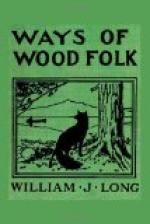The swooping habit leads them into queer mistakes sometimes. Two or three times, when sitting or lying still in the woods watching for birds, my head has been mistaken for a rat or squirrel, or some other furry quadruped, by owls, which swooped and brushed me with their wings, and once left the marks of their claws, before discovering their mistake.
Should any boy reader ever have the good fortune to discover one of these rare birds some winter day in tramping along the beaches, and wish to secure him as a specimen, let him not count on the old idea that an owl cannot see in the daytime. On the contrary, let him proceed exactly as he would in stalking a deer: get out of sight, and to leeward, if possible; then take every advantage of bush and rock and beach-grass to creep within range, taking care to advance only when his eyes are turned away, and remembering that his ears are keen enough to detect the passing of a mouse in the grass from an incredible distance.
Sometimes the crows find one of these snowy visitors on the beach, and make a great fuss and racket, as they always do when an owl is in sight. At such times he takes his stand under a bank, or in the lee of a rock, where the crows cannot trouble him from behind, and sits watching them fiercely. Woe be to the one that ventures too near. A plunge, a grip of his claw, a weak caw, and it’s all over. That seems to double the crows’ frenzy—and that is the one moment when you can approach rapidly from behind. But you must drop flat when the crows perceive you; for the owl is sure to take a look around for the cause of their sudden alarm. If he sees nothing suspicious he will return to his shelter to eat his crow, or just to rest his sensitive ears after all the pother. A quarter-mile away the crows sit silent, watching you and him.
And now a curious thing happens. The crows, that a moment ago were clamoring angrily about their enemy, watch with a kind of intense interest as you creep towards him. Half way to the rock behind which he is hiding, they guess your purpose, and a low rapid chatter begins among them. One would think that they would exult in seeing him surprised and killed; but that is not crow nature. They would gladly worry the owl to death if they could, but they will not stand by and see him slain by a common enemy. The chatter ceases suddenly. Two or three swift fliers leave the flock, circle around you, and speed over the rock, uttering short notes of alarm. With the first sharp note, which all birds seem to understand, the owl springs into the air, turns, sees you, and is off up the beach. The crows rush after him with crazy clamor, and speedily drive him to cover again. But spare yourself more trouble. It is useless to try stalking any game while the crows are watching.
Sometimes you can drive or ride quite near to one of these birds, the horse apparently removing all his suspicion. But if you are on foot, take plenty of time and care and patience, and shoot your prize on the first stalk if possible. Once alarmed, he will lead you a long chase, and most likely escape in the end.




